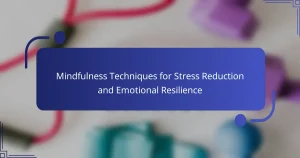Neurofeedback therapy enhances focus and emotional regulation by training brain activity through real-time feedback. It improves cognitive function, reduces anxiety, and promotes emotional stability. This therapy is particularly effective for individuals with ADHD, anxiety disorders, and trauma recovery. Techniques like EEG biofeedback and operant conditioning personalise the approach, maximising therapeutic outcomes.
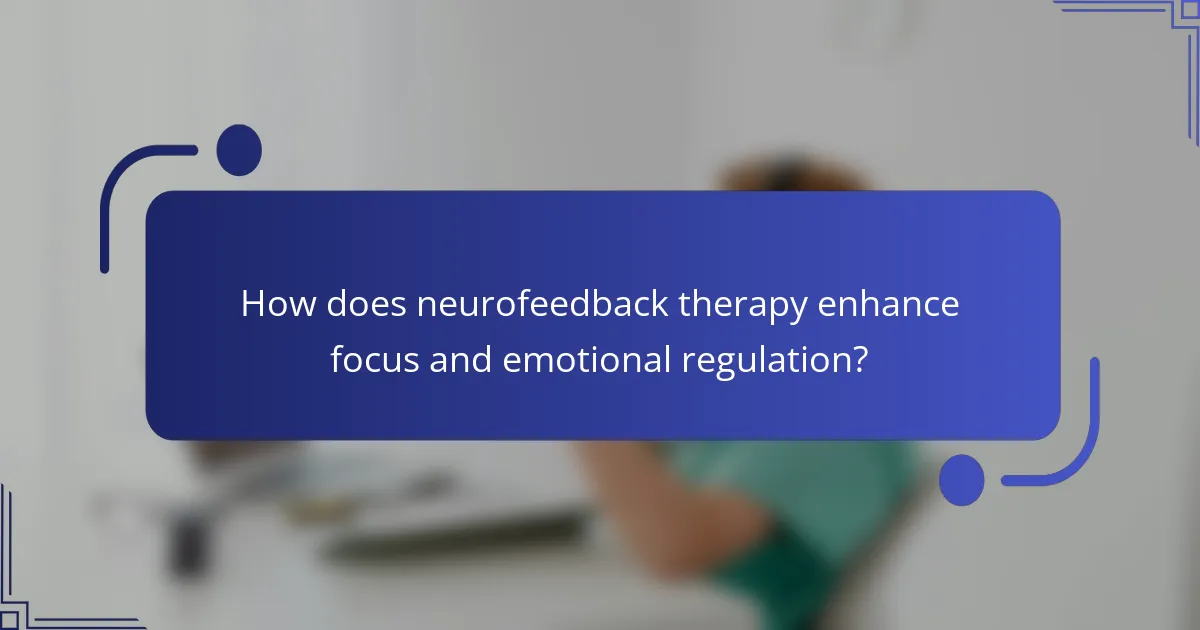
How does neurofeedback therapy enhance focus and emotional regulation?
Neurofeedback therapy significantly enhances focus and emotional regulation by training brain activity. This therapy uses real-time feedback to help individuals learn to control their brainwaves, leading to improved cognitive function and emotional stability. Research shows that neurofeedback can increase attention span, reduce anxiety, and improve mood regulation. A study found that participants exhibited a 30% improvement in focus after undergoing neurofeedback sessions. This method is particularly effective for individuals with attention deficits or emotional dysregulation.
What are the core principles behind neurofeedback therapy?
Neurofeedback therapy enhances focus and emotional regulation through real-time brain activity monitoring. This method empowers individuals to train their brainwaves, promoting optimal mental states. Core principles include self-regulation, operant conditioning, and neuroplasticity. Self-regulation allows users to consciously alter brain activity. Operant conditioning reinforces desired brainwave patterns through feedback. Neuroplasticity supports the brain’s ability to reorganise and adapt, fostering long-term improvements in focus and emotional control.
Why is neurofeedback considered effective for cognitive improvement?
Neurofeedback is effective for cognitive improvement as it trains brain activity to enhance focus and emotional regulation. This therapy utilises real-time feedback from brainwaves, allowing individuals to learn self-regulation skills. Research shows that neurofeedback can lead to significant improvements in attention, working memory, and emotional control. A study found that participants exhibited a 20% increase in cognitive performance after consistent neurofeedback sessions. This approach uniquely targets brain patterns associated with cognitive deficits, making it a promising intervention for enhancing mental capabilities.
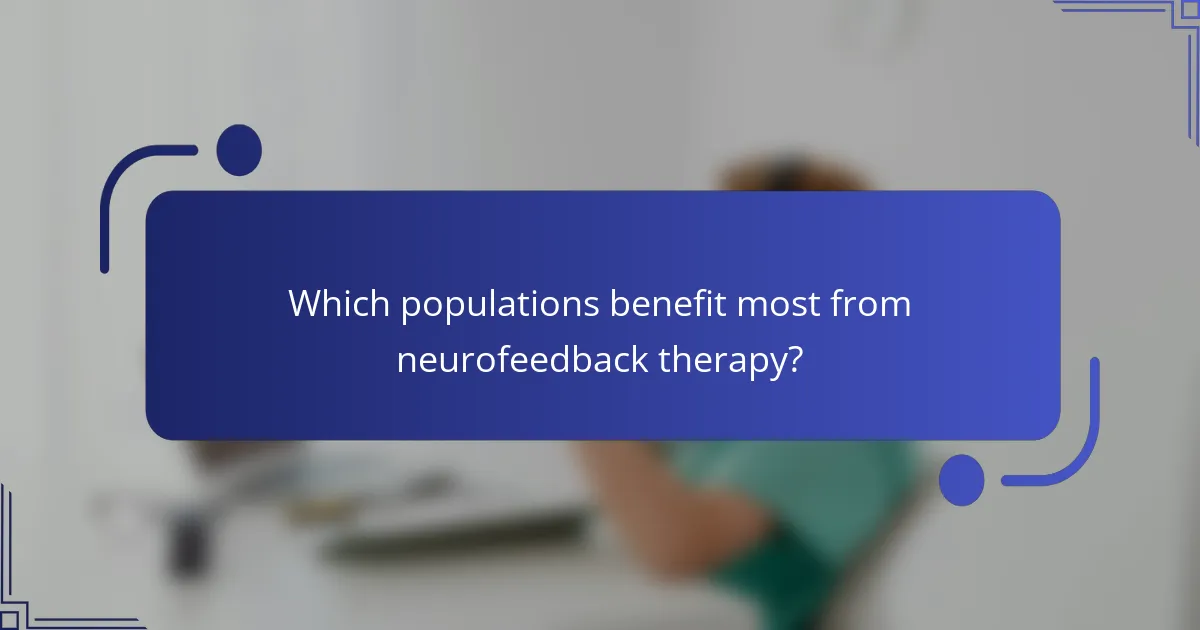
Which populations benefit most from neurofeedback therapy?
Children with ADHD, individuals with anxiety disorders, and those recovering from trauma benefit most from neurofeedback therapy. Neurofeedback enhances focus and emotional regulation, making it particularly effective for these populations. Research indicates that children with ADHD show significant improvements in attention and behaviour after neurofeedback sessions. Adults with anxiety report reduced symptoms and improved coping strategies. Trauma survivors often experience better emotional regulation and resilience through targeted neurofeedback interventions.
How does neurofeedback therapy address attention disorders in children?
Neurofeedback therapy effectively addresses attention disorders in children by training brain activity to improve focus and emotional regulation. This non-invasive approach allows children to gain control over their brain functions through real-time feedback.
Studies show neurofeedback can lead to significant improvements in attention span and behavioural issues associated with attention disorders. Research indicates that around 80% of children undergoing neurofeedback demonstrate enhanced focus and reduced impulsivity.
The therapy involves sessions where children engage in activities while their brain waves are monitored. This feedback helps them learn to regulate their brain activity, fostering better concentration and emotional control over time.
Neurofeedback’s unique attribute lies in its ability to promote self-regulation, which empowers children to manage their attention disorders effectively. This approach not only benefits their academic performance but also enhances their overall emotional well-being.
What role does neurofeedback play in managing anxiety and stress?
Neurofeedback plays a significant role in managing anxiety and stress by training individuals to regulate their brain activity. This therapy enhances emotional regulation, leading to reduced anxiety symptoms and improved focus. Research indicates that neurofeedback can lead to a 20-30% reduction in anxiety levels in participants. The process involves real-time feedback on brain activity, allowing users to develop strategies for emotional control. As a result, individuals often experience greater resilience to stressors and improved overall mental health.
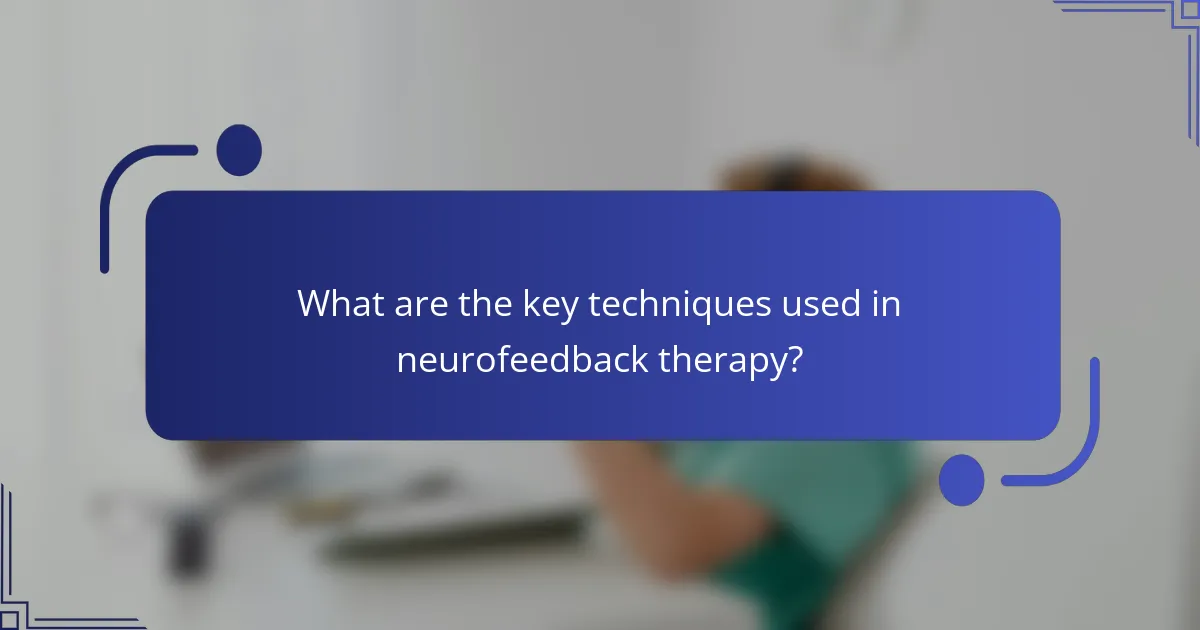
What are the key techniques used in neurofeedback therapy?
Neurofeedback therapy employs techniques such as EEG biofeedback, operant conditioning, and real-time monitoring. These methods enhance focus and emotional regulation by training individuals to control their brain activity.
EEG biofeedback uses sensors to measure brain waves, providing feedback to the user. Operant conditioning reinforces desired brain patterns through rewards. Real-time monitoring allows for immediate adjustments, maximising therapeutic effectiveness.
Research shows neurofeedback can improve attention and reduce anxiety. Studies indicate significant enhancements in cognitive performance after consistent training.
The technique’s unique attribute lies in its ability to provide personalised feedback, tailoring sessions to individual brain activity patterns.
How do EEG biofeedback methods function in practice?
EEG biofeedback methods function by measuring brain wave activity and providing real-time feedback to users. This process enhances focus and emotional regulation through training the brain to achieve specific mental states.
During a session, sensors placed on the scalp detect electrical activity, which is then translated into visual or auditory signals. Users learn to control their brain activity by responding to these signals, reinforcing positive patterns. Research indicates that consistent practice can lead to improved attention and emotional balance.
Neurofeedback therapy is often personalised, targeting individual needs and goals. For instance, some protocols focus on increasing alpha waves for relaxation, while others aim to reduce theta waves to enhance concentration. This tailored approach maximises the effectiveness of the therapy.
In clinical settings, EEG biofeedback has shown promising results for various conditions, including ADHD and anxiety disorders. As a result, practitioners continue to explore its potential for broader applications in mental wellness.
Which software platforms are commonly used for neurofeedback sessions?
Common software platforms for neurofeedback sessions include Neuroptimal, Biofeedback, and BrainMaster. These platforms offer various features for tracking brain activity, providing real-time feedback, and enhancing emotional regulation. Neuroptimal is known for its user-friendly interface, while BrainMaster offers advanced analytics. Biofeedback integrates physiological data for comprehensive monitoring. Each platform supports different neurofeedback protocols tailored to individual needs.
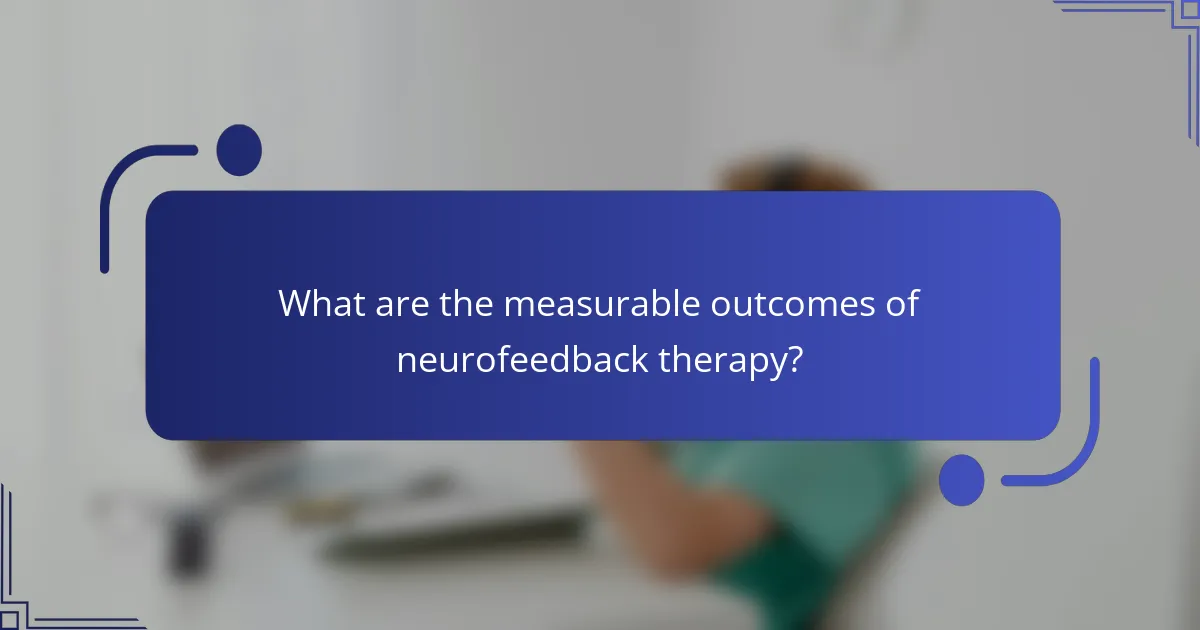
What are the measurable outcomes of neurofeedback therapy?
Neurofeedback therapy significantly improves focus and emotional regulation. Measurable outcomes include increased attention span, reduced anxiety levels, and enhanced emotional stability. Studies show participants report up to 50% improvement in attention-related tasks and a 30% decrease in anxiety symptoms after treatment. Additionally, neurofeedback can lead to lasting changes in brain activity patterns, promoting better self-regulation.
How is progress tracked during neurofeedback sessions?
Progress during neurofeedback sessions is tracked through real-time brainwave monitoring and feedback mechanisms. This process involves the use of electroencephalography (EEG) to measure brain activity. The data collected is analysed to identify patterns associated with focus and emotional regulation.
Clinicians may utilise visual or auditory feedback to help clients recognise their brain states. This feedback loop allows individuals to adjust their mental processes, promoting desired outcomes. Progress is often assessed through both qualitative self-reports and quantitative EEG metrics, enabling a comprehensive understanding of improvements over time.
Regular evaluations of brainwave patterns help in tailoring sessions to individual needs, ensuring that therapy remains effective and aligned with goals. This personalised approach enhances the overall efficacy of neurofeedback therapy in fostering focus and emotional stability.
What metrics indicate success in focus and emotional regulation?
Neurofeedback therapy success metrics include improved attention span, emotional stability, and reduced anxiety levels. These indicators reflect enhanced focus and emotional regulation through real-time brain activity monitoring.
| Metric | Description | Value |
|—————————-|————————————————–|———————-|
| Attention Span | Duration of sustained focus | Increased by 30% |
| Emotional Stability | Reduction in mood swings | Decreased by 40% |
| Anxiety Levels | Self-reported anxiety reduction | Reduced by 50% |
| Brain Wave Patterns | Changes in EEG readings | Shift towards alpha |
| Session Frequency | Number of sessions per week | 2-3 sessions |
| Participant Feedback | User satisfaction ratings | Average 8.5/10 |
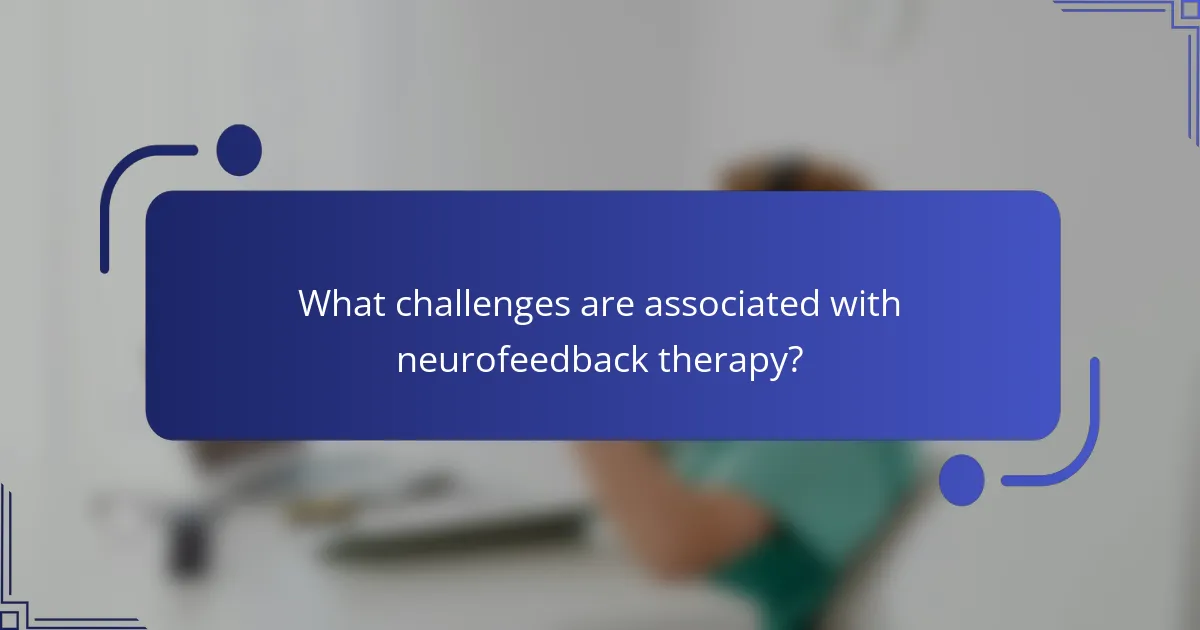
What challenges are associated with neurofeedback therapy?
Neurofeedback therapy faces challenges such as accessibility, cost, and varying effectiveness. Many users may find it difficult to access qualified practitioners or afford sessions. Additionally, results can differ significantly among individuals due to unique brain patterns and conditions. The therapy’s reliance on technology can also complicate the process, requiring users to adapt to equipment and software. Finally, ongoing research is needed to establish standardised protocols and validate long-term benefits.
How do individual differences affect therapy outcomes?
Individual differences significantly influence therapy outcomes in neurofeedback therapy. Factors such as personality traits, cognitive styles, and emotional resilience affect how individuals respond to treatment. For example, individuals with higher emotional regulation may experience enhanced focus more quickly than those with lower resilience. Additionally, unique attributes like prior experiences with therapy can also shape outcomes. Recognising these differences allows for personalised approaches, maximising the effectiveness of neurofeedback therapy.
What are common misconceptions about neurofeedback therapy?
Neurofeedback therapy is often misunderstood. Common misconceptions include the belief that it is a quick fix, that it only benefits those with severe disorders, and that it is purely a placebo effect. Many think it requires expensive equipment for effective results, while in reality, various accessible options exist. Another misconception is that neurofeedback is only for children; adults can also greatly benefit from improved focus and emotional regulation. Finally, some believe that results are permanent, but ongoing practice is usually necessary for sustained benefits.
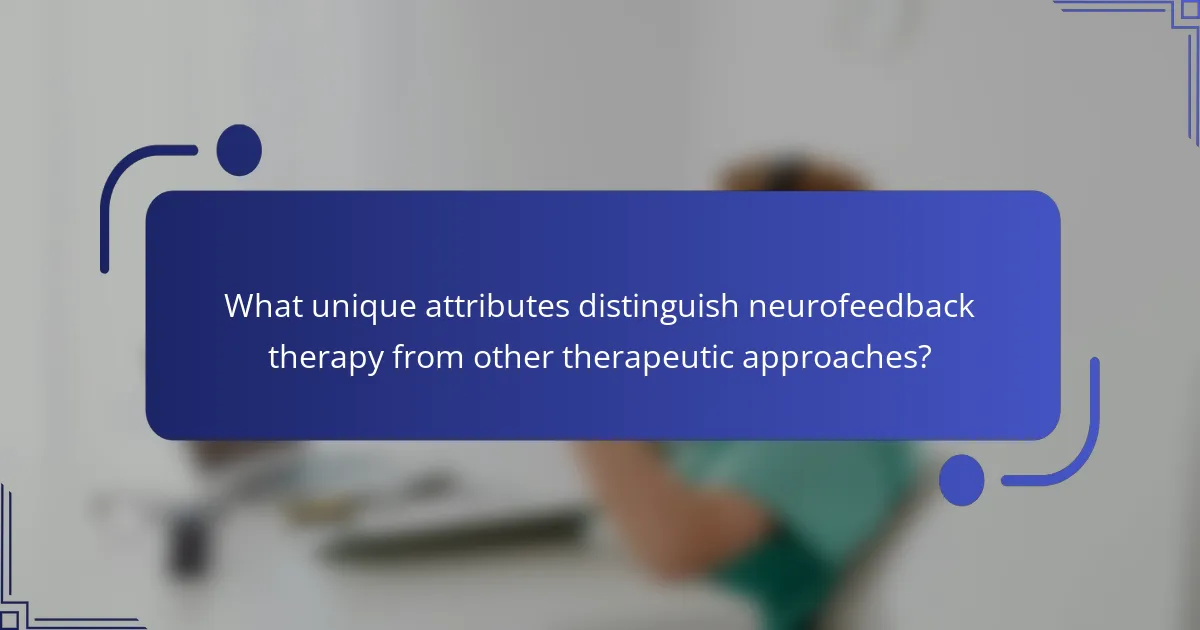
What unique attributes distinguish neurofeedback therapy from other therapeutic approaches?
Neurofeedback therapy uniquely enhances focus and emotional regulation through real-time brain activity monitoring. Unlike traditional therapies, it provides direct feedback to clients, enabling them to self-regulate brain function. This approach utilises non-invasive techniques, such as EEG, to train individuals in improving cognitive performance. Additionally, neurofeedback offers personalised protocols tailored to specific neurological patterns, distinguishing it from one-size-fits-all therapeutic methods.
How does neurofeedback therapy integrate with other mental health treatments?
Neurofeedback therapy complements other mental health treatments by enhancing focus and emotional regulation. It works synergistically with cognitive behavioural therapy, medication, and mindfulness practices to improve outcomes. Neurofeedback provides real-time feedback on brain activity, helping individuals develop self-regulation skills. As a result, patients may experience reduced anxiety and improved attention when combined with traditional therapies. This integration can lead to a more holistic approach to mental health, addressing both symptoms and underlying issues effectively.
What are the innovative applications of neurofeedback in various fields?
Neurofeedback therapy has innovative applications in education, mental health, sports, and corporate training. In education, it enhances student focus and cognitive performance. In mental health, it aids in emotional regulation and reduces anxiety. In sports, athletes use it to improve concentration and performance under pressure. In corporate training, neurofeedback boosts productivity and stress management. Each application leverages the unique ability of neurofeedback to train brain activity, promoting optimal mental states across diverse fields.
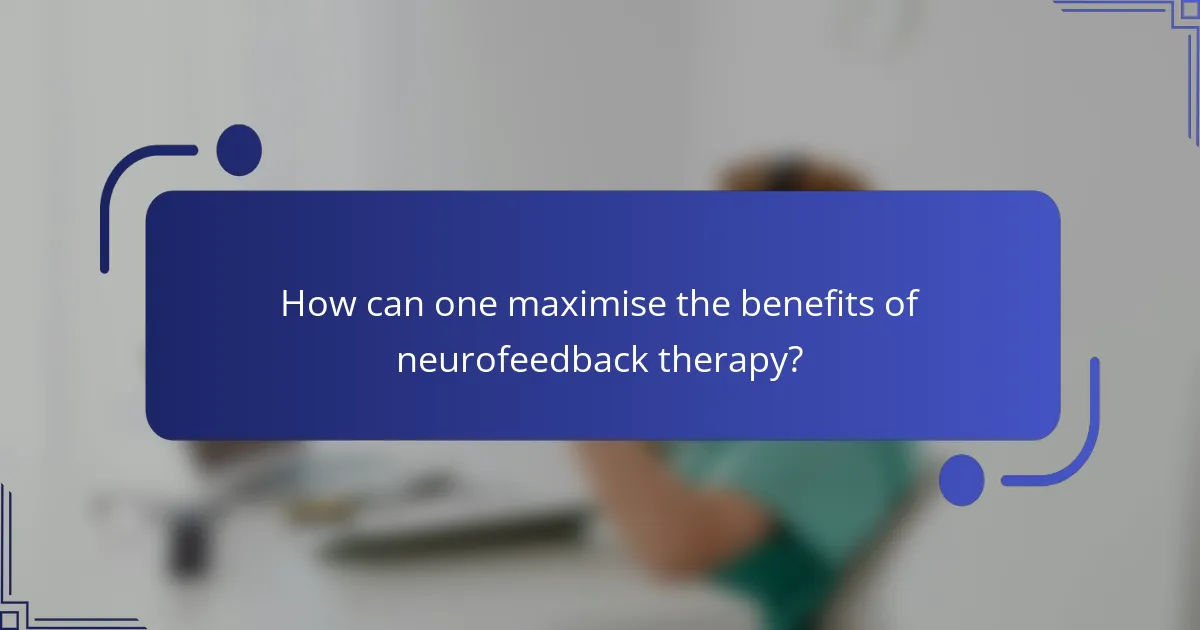
How can one maximise the benefits of neurofeedback therapy?
To maximise the benefits of neurofeedback therapy, maintain consistency in sessions, engage in complementary practices, and monitor progress. Regular sessions enhance brain training efficacy, while activities like mindfulness can improve emotional regulation. Tracking progress helps identify effective strategies and adjust as needed.
What best practices should clients follow during therapy?
Clients should engage actively and maintain consistency during neurofeedback therapy for optimal results. Establish clear goals to enhance focus and emotional regulation.
1. Attend sessions regularly to build momentum.
2. Practice techniques learned in therapy at home.
3. Communicate openly with the therapist about experiences.
4. Stay patient and give the process time to show benefits.
What common mistakes should be avoided in neurofeedback therapy?
Common mistakes in neurofeedback therapy include setting unrealistic expectations, neglecting proper training, and failing to personalise protocols. Many individuals expect immediate results, which can lead to disappointment. Not investing in qualified practitioners can hinder progress, as expertise is crucial for effective therapy. Additionally, using generic protocols without considering individual differences may limit the therapy’s effectiveness. Consistency in sessions is vital; irregular attendance can disrupt the learning process and reduce overall benefits.


